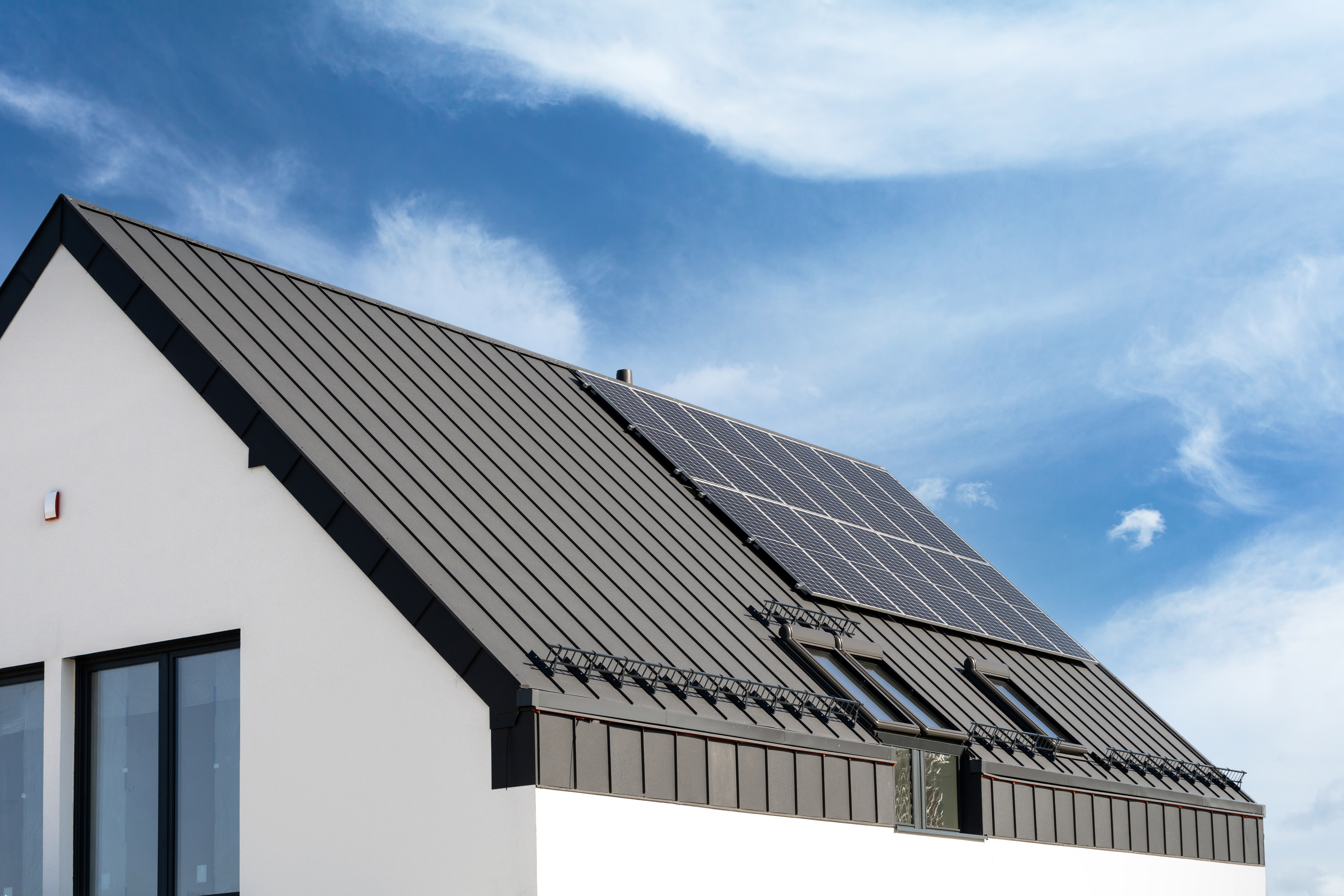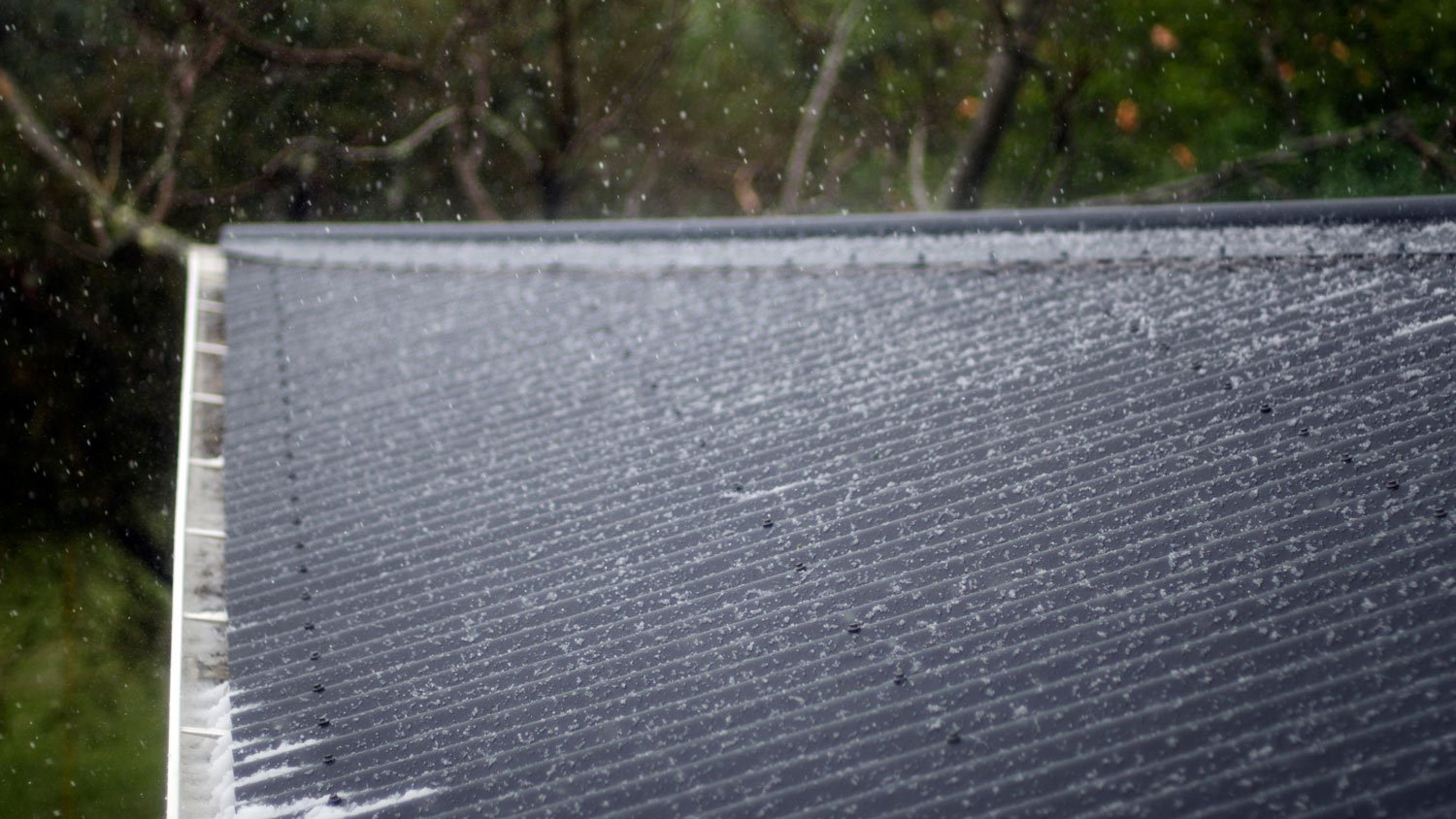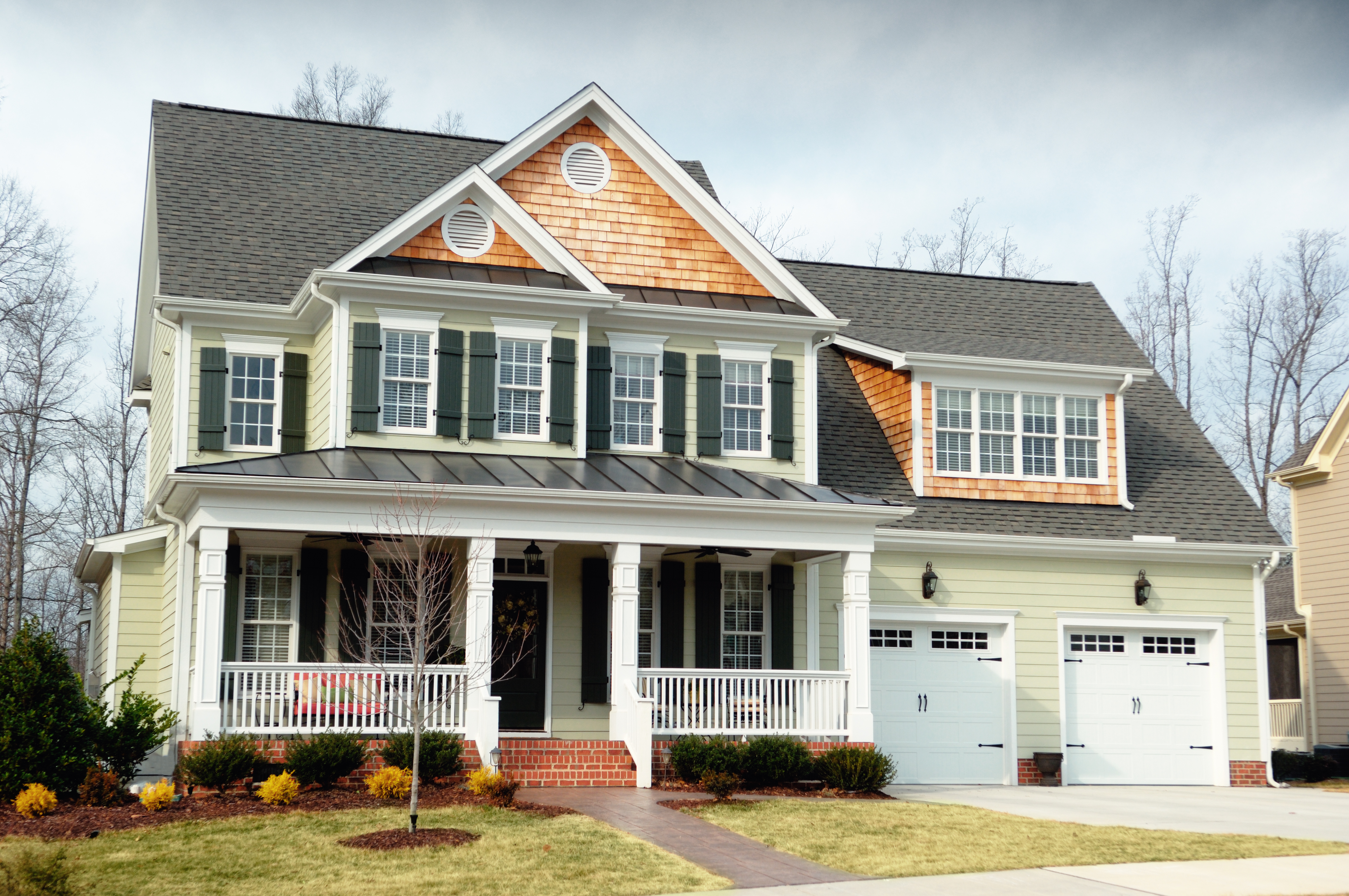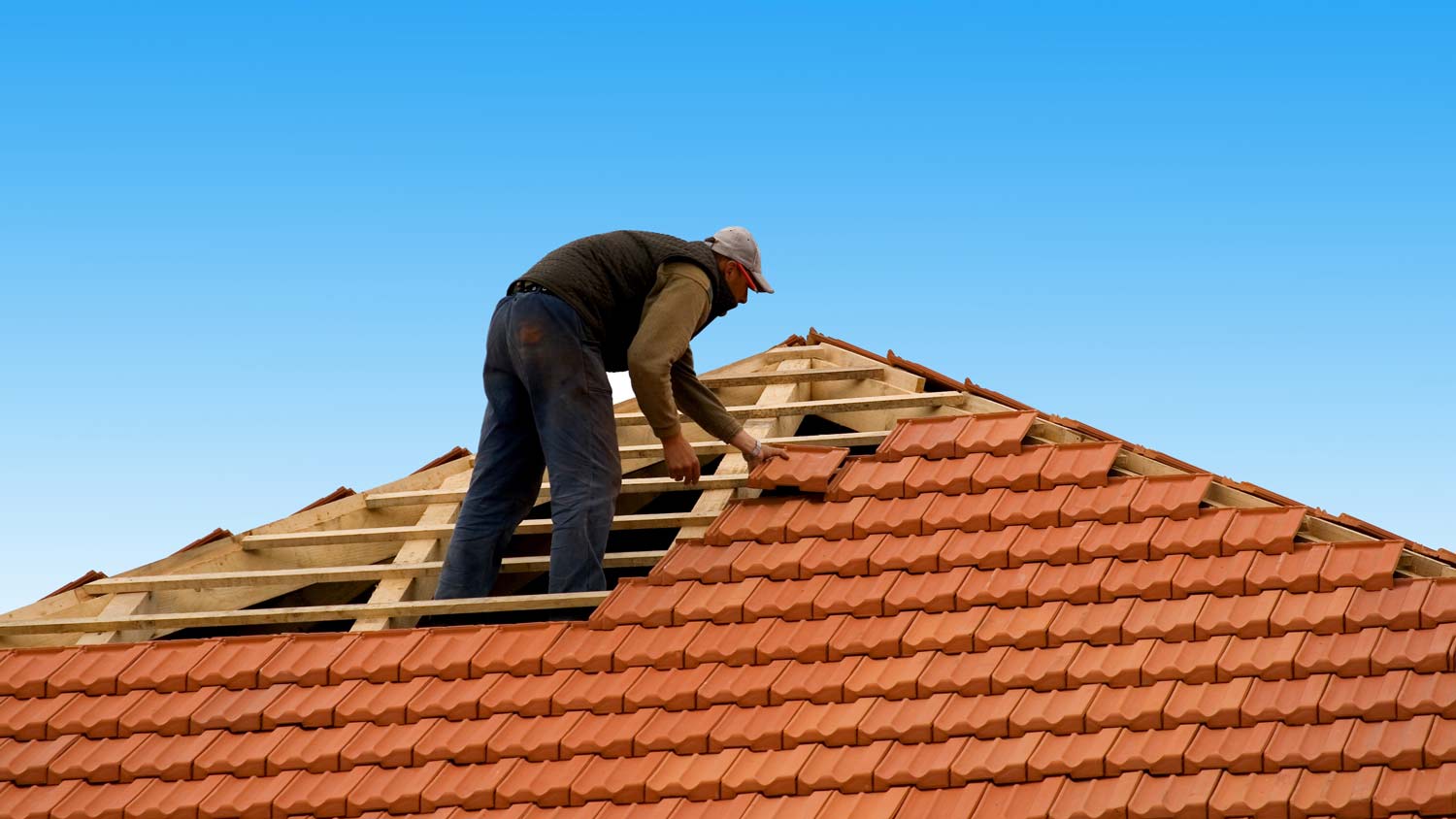
A metal roof can defend your home against Ohio’s varying weather conditions. Learn how much a metal roof costs in Columbus, OH.
It doesn’t take much to make a dent in most roofs


One-inch-sized hail or larger can damage a roof.
Metal roofs are more hail resistant than shingles.
Contact a roofing contractor first for an assessment.
An insurance adjuster decides if insurance will cover repair or replacement.
Consider a replacement for a leak-proof roof.
There is something nostalgic about listening to rain on the roof on a hot summer night. But if the storm turns fierce and you hear a loud clattering, chances are that hail has arrived. Hail can cause serious damage to your roof. In fact, you may need to replace your roof if it suffers seven to 10 hail impact marks in a 10-square foot area. But other factors are at play, including your specific insurance policy. Here’s a look at how much hail damage you need to replace a roof.

Hailstorms can sound scary, and even just a short burst of hail can have serious ramifications for your roof and home. Hailstones that measure an inch in diameter— the size of a quarter—or larger can damage roofs, gutters, and other parts of your home. A lot of smaller hail, however, can cause damage, too, especially to roofing that is already old or worn.
Most hailstones are rounded, and that can help protect roofing from smaller hail; but unfortunately, since they are rock-hard pieces of ice, larger hail can pack a punch that breaks and cracks shingles, causes dents, and leaves roofs vulnerable to leaks. That is why it is important to have an insurance adjuster or a roofing contractor check out your roof after storms that drop hail.
Any roof damage can lead to leaks and bigger problems in the future, so you should have any potential hail damage inspected and fixed right away.
After a storm, you can look at your roof from the ground to see if it sustained any visible signs of damage. It is also smart to look around your property; if your vehicle or other parts of your home were damaged by the hail, it is unlikely that your roof escaped the onslaught. Call your insurance company or a roofing contractor right away if you see damage. However, even if you do not see obvious dings or dents, it is best to have an expert inspect the roof closely to identify any problems, including the following:
Asphalt shingles are soft and can dent easily under the impact of hailstones, especially those that are an inch in diameter or bigger. In many cases, dents will be visible from the ground, as these result when falling hail knocks off colored granules and exposes the darker asphalt layers below. Even small dents or dings can weaken shingles and allow water to seep below your roofing, so do not ignore them.
In some cases, shingles can be cracked, broken, or even torn from the roof by severe hailstorms. These are emergency cases, as cracks, tears, and breaks in shingles and missing shingles leave roofing extremely vulnerable to water intrusion, leaks, and even more damage. In some cases, broken and missing shingles can be replaced when the damage is localized, but when the storm is severe enough to cause that much damage, roof replacement may be necessary.
It is normal for shingles to lose granules as they age, but severe storms and hail can knock off more granules much faster than average wear. The easiest way to check for missing granules is to look at the base of downspouts after a storm. If you see piles of shingle granules, you will know that your roof is losing them at a fast rate. Even if no other damage is visible, it is smart to have an expert look at your shingles and advise whether it is time to replace them or if they still have life left.
Roofing is not the only part of your roof that hail will damage. Gutters, downspouts, roof vents, drip edges, and other parts of your roofing system are vulnerable to dents, dings, scratches, dislodging, and other damage. In fact, sometimes they are even more likely to sustain damage because they can be made of softer materials than shingles. After a storm, have a roofing contractor or insurance adjuster verify whether these parts of your roof system need repair or replacement, along with your roof.
Hail is heavy, and when enough hailstones collect in your gutters and impede water from flowing down and out, they can make gutter systems heavy enough to tear them from your roof. If this happens, simply replacing your gutters may not be enough. Often, collapsed gutters pull, dislodge, damage, or compromise the first row of shingles, which can leave your entire roof system and home vulnerable to seeping water.
It takes a pretty big hailstone to puncture a roof, but it does happen, especially on older roofs or roofing that is already worn or in bad condition. In some storms, hail can reach epic proportions, including softball-sized hail. These monster hailstones can fall with such a thud that they puncture asphalt shingles and tear a hole in roofing and possibly even the roof decking below.
Sometimes everything seems fine after a storm—until it is not. If you notice roof leaks or water stains in your attic or on your ceiling, walls, or other structural areas of your home, call an expert right away. These can be signs that water is getting in at the roof level or other part of your home, and that can be a precursor to major damage.
Be aware, though, that leaks are not always fresh water that pools. They often show up as dark spots, spreading dark areas, soft areas in drywall or ceilings, water in ceiling-mounted light fixtures, or drips that seem to appear out of nowhere.

Hail damage can happen quickly and it can be severe or invisible from the ground. Here is what to do if you have hail damage or are worried you might.
If you would like help paying for a roof replacement, chances are good that your homeowners’ insurance policy has a protocol for hail damage insurance claims. Your roof will need to be evaluated by an insurance adjuster. A roof repair contractor near you can help speed up the insurance process by giving the damage an initial review and providing you with an assessment. If they believe that it may be a good candidate for a replacement, they will suggest you get in touch with an insurance adjuster.
Insurance adjusters come to your home, survey the exterior of your home, and climb up on the roof to get a closer look at the hail damage. Their findings will help inform the next steps for a claim. While they are on the roof, they are looking for a couple of things, including the roof's age, quality of installation, routine maintenance, and signs of damage, like granule loss, exposed surfaces or flashing, holes, and punctures.
The choice to repair or replace may not actually be your choice. In most cases, your insurance company and the extent of the damage will be the deciding factors in whether repair is possible or replacement is necessary. In either case, you will want to address the problem quickly to prevent further damage to your roof and home.
Severe damage requires replacement, as does a combination of other factors, such as moderate damage to a roof that was already teetering on the need for replacement. Roofing contractors can often repair moderate to minimal damage, however. This can be as simple as replacing damaged or missing shingles, and may be completely covered by your insurance.
To protect yourself, it is smart to review your homeowners’ insurance policy, especially how it covers hail damage, before you need it. If the terms are not acceptable to you, now is the time to make changes. You will need to balance premiums and deductibles with coverage and likelihood of needing it, though, so weigh your options carefully.
From average costs to expert advice, get all the answers you need to get your job done.

A metal roof can defend your home against Ohio’s varying weather conditions. Learn how much a metal roof costs in Columbus, OH.

Dealing with a visibly damaged roof or leak? Learn about roof repair costs in Columbus to see how much you’ll need to budget for a permanent solution.

Learn about roof replacement costs in Columbus and what factors are at play to budget accurately and make sure you’re getting a fair price.

Flat roofs need regular maintenance to prevent leaks and keep leaves and debris from causing damage. Avoid pricey repairs with these seven flat roof maintenance tips.

Find out the average tile roof repair cost, key price factors, and ways to save. Get expert tips to plan your tile roof repair project with confidence.

Roof sealant helps protect your roof from the elements. Learn about different types of roof sealant and how to pick the right one for your roof.